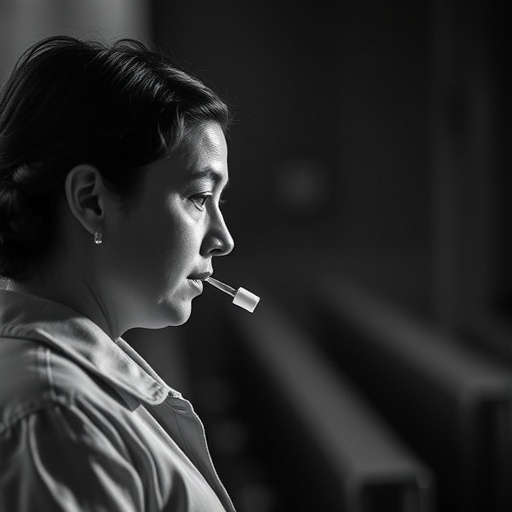Reporting results from a first-in-human phase I clinical trial, researchers at University of California San Diego School of Medicine have found that treatment with cirmtuzumab, an experimental monoclonal antibody-based drug, measurably inhibited the "stemness" of chronic leukemia cancer (CLL) cells — their ability to self-renew and resist terminal differentiation and senescence.
The findings are published in the June 1 issue of Cell Stem Cell.
"In this trial, we treated 26 patients with relapsed CLL with increasing amounts of cirmtuzumab, which we found was exceptionally well-tolerated. Patients received only a short-course of treatment and this appeared to halt disease progression, allowing most patients to forego any additional therapy for more than eight months," said Michael Choi, MD, assistant clinical professor and first author of the paper. "This is noteworthy as the patients who enrolled in the trial had leukemia that was getting worse and causing disruption of normal blood production or other clinical problems."
CLL is the most common form of blood cancer in adults, resulting in a progressive and deadly overabundance of white blood cells, called lymphocytes. CLL accounts for roughly one quarter of new cases of leukemia (21,000) annually and roughly 4,500 deaths each year.
Cirmtuzumab targets a molecule called ROR1 that normally is used only by embryonic cells during early development, but which is abnormally exploited by cancer cells to promote tumor growth and spread, otherwise known as metastasis. Metastasis is responsible for 90 percent of all cancer-related deaths.
Because ROR1 is not used by normal adult cells, scientists believe it is a unique marker of cancer cells in general and cancer stem cells in particular. The latter often elude or become resistant to cancer therapies, allowing treated cancers to recur. ROR1 appears to drive tumor growth and disease spread and scientists think that presents an excellent novel target for anti-cancer therapy.
Choi, with senior authors Thomas Kipps, MD, PhD, Distinguished Professor of Medicine and deputy director of research at UC San Diego Moores Cancer Center, Catriona Jamieson, MD, PhD, deputy director of UC San Diego Moores Cancer Center, and colleagues describe the results of the clinical trial and their findings that treatment with cirmtuzumab can block the capacity of ROR1 to drive tumor growth, self-renewal and metastasis.
"We are excited by the finding that the leukemia cells of treated patients reversed their expression pattern of thousands of genes associated with what's called oncogenic dedifferentiation or 'stemness,' which is associated with the capacity of cancer cells to self-renew and spread throughout the body," said Kipps, whose group originally developed cirmtuzumab as one of six projects initially funded through the California Institute for Regenerative Medicine's (CIRM) HALT leukemia grant to co-principal investigators Jamieson and Dennis Carson, MD.
"This was a phase I safety trial with specific, limited goals, which it met with encouraging results," said Jamieson, who also heads the CIRM-funded Alpha Clinic, which is investigating therapies using stem cells or, in the case of cancer, targeting cancer stem cells.
Cancer stem cells are believed responsible for failure of conventional treatments to eradicate most types of cancer. In this regard, said Jamieson, cirmtuzumab's therapeutic potential may not to be limited to patients with CLL, noting that "prior research by Kipps and colleagues found cirmtuzumab may be effective in targeting cancer stem cells in patients with other cancers, such as ovarian or breast cancer."
Additional clinical studies of cirmtuzumab are ongoing or planned. Earlier this year, UC San Diego researchers launched a phase Ib/II clinical trial to evaluate the combined effectiveness of a standard of care drug called ibrutinib (marketed as Imbruvica) with cirmtuzumab to B-cell malignancies, which include leukemias and lymphomas.
"The next step is to pursue a phase II trial with more patients that will inform us more specifically about how and how well the treatment works," said Jamieson.
For the cirmtuzumab trial, the UC San Diego researchers are collaborating with Oncternal Therapeutics, a San Diego-based biotechnology company which has a license from UC San Diego to develop and commercialize antibodies and antibody-related binding agents stemming from research of Kipps and colleagues.
"Vital support from a CIRM clinical grant, the Sanford Stem Cell Clinical Center, Oncternal and the CIRM Alpha Stem Cell Clinic Network will expand access to this cutting-edge cancer stem cell targeted therapy for the benefit of patients throughout California," said Jamieson.
###
Co-authors of the study are: George F. Widhopf II, Emanuela M. Ghia, Reilly L. Kidwell, Md Kamrul Hasan, Jian Yu, Laura Z. Rassenti, Liguang Chen, Yun Chen, Emily Pittman, Minya Pu, Karen Messer, Charles E. Prussak and Januario E. Castro, all at UC San Diego.
Media Contact
Scott LaFee
[email protected]
858-249-0456
@UCSanDiego
http://www.ucsd.edu
http://dx.doi.org/10.1016/j.stem.2018.05.018




